Tiempo Climate Cyberlibrary
Youth and the Environment
 |
Federica Meneghetti reports on an innovative
project involving young people in the three countries
of Argentina, China and Mozambique.
|
|
The author works with the UN Convention to
Combat Desertification as a liaison officer with the
Italian Government providing assistance and support
in the development of bilateral activities and pilot
projects. Previously she worked with UNESCO and the
Food and Agricultural Organization.
|
In 1994, aware that the livelihoods of over 1.2 billion
people were threatened or are at risk because of drought
and desertification, the Parties to the Rio Convention
adopted the United Nations Convention to Combat
Desertification (UNCCD).
The UNCCD mandate attempts not only to tackle the
impacts of desertification but also to mitigate the effects
of the resulting droughts. This process is undertaken
through policies and measures to be directly implemented in
dry land areas which are vulnerable to over-exploitation
and inappropriate land-use as a result of poverty,
political instability, deforestation, overgrazing and poor
irrigation techniques.
Over the past two decades, the problem of land
degradation in dryland regions has continually worsened.
The Convention represents, therefore, a much needed
political and operational consensus on the measures for
preventing and rehabilitating degraded land.
In recognition of the principles of participation,
partnership and decentralization, the Convention advocates
a spirit of partnership as the basis upon which the states
affected by desertification and donor countries should
cooperate. The Convention requires its parties to guarantee
that all relevant ‘actors’ will cooperate in
setting priorities, developing long-term programmes and
implementing them. These ‘actors’ comprise of
local communities, women and youth groups, non-governmental
organizations, national governments, donor agencies and
scientific research institutions.
The bottom-up approach of the Convention helps to
significantly strengthen relationships between governments
and local communities, particularly in larger countries.
This approach favours the decentralized involvement of the
stakeholders and the end users of natural resources.
Experience gained so far in trying to tackle poverty,
land degradation, climate change and loss of biodiversity,
suggests that synergistic approaches are the most effective
in the development and implementation of activities that
would help to meet the broad objectives of the Rio
Conventions. It has been widely recognized that forestry
offers a good deal of opportunity for a synergistic
approach. It is important, therefore, to promote carefully
designed forestry activities to enable the fostering of
cooperation and coordination among these Conventions. It is
important also to identify synergies as a tool to achieve
sustainable development as stated by the World Summit on
Sustainable Development.
In view of the foregoing, the Italian Ministry for the
Environment and Territory and the United Nations Convention
to Combat Desertification (UNCCD) agreed to launch an
innovative experience in Argentina, China and Mozambique.
The initiative is to target job creation for youth and to
seek to strengthen synergies in the forest sector between
the three Conventions of Biodiversity, Climate Change, and
Desertification.
The objectives of the projects are to rehabilitate
degraded land, create income-generating activities, to
sequester carbon and to restore and protect biodiversity.
At the same time, the projects will endeavour to raise
awareness and strengthen the role of youth and civil
society organizations through the promotion of sustainable
development in these fragile ecosystems.
In a broader view, the general objective of the projects
is to enhance the capacity for implementing sustainable
development policies at the local level. This will promote
community awareness and will involve the participation of
young people in safeguarding the environment. To achieve
this objective, a bottom-up approach has been adopted which
will mobilize the youth to undertake the reforestation
activities at the same time as providing them with
experience and employment opportunities.
The projects will also increase the capacity of these
communities for implementing sustainable development
policies, particularly those related to the UNCCD process
under the participating countries' National Action
Programme to Combat Desertification and Drought.
Through the afforestation and reforestation of an
average of 3,000 hectares in each country with native
species, the projects will specifically contribute to:
- sequestering carbon, thereby mitigating climate
change;
- creating job opportunities and improve socio-economic
conditions within the area of influence of the forest;
and
- increasing environmental awareness, particularly
among the youth.
The projects will be implemented in areas where they can
address, through the implementation of reforestation
schemes, the issues of poverty, land degradation, carbon
sequestration and loss of biodiversity at the same
time.
The areas are the Province of Santiago del Estero
(Argentina), Aohan County of Chifeng Municipality of Inner
Mongolia (China) and Tete Province (Mozambique). All three
areas are severely degraded in one way or the other. This
degradation is due to either heavy agricultural use,
overgrazing and uncontrolled clearing, or natural land
degradation. Furthermore, all three projects are located in
poverty stricken areas.
Environmental Youth Groups, Santiago del Estero
Province, Argentina
The goals of the project are:
- the establishment of 12 Environmental Youth Groups in
12 rural communities as well as the establishment of a
permanent regional environmental network;
- the training of 240 young people in environmental and
social organization issues together with offering 120
young people employment opportunities;
- eight tree nurseries to be established thus providing
seedlings for national and provincial
reforestation/afforestation programmes;
- the afforestation/reforestation of 3,000 hectares
through the conversion of pastures or degraded areas into
woodlands thereby resulting in a net increase of the
carbon stock in the biomass; and,
- implementing the first “Sinks in Clean
Development Mechanism” project in Argentina.
The project will be implemented in the province of
Santiago del Estero, located in the north of Argentina, in
one of the poorest and least developed areas in the
country.
The region suffers from the effects of El Niño.
Large saltpans of calcium carbonate are evidence of severe
land degradation due to poor irrigation practices.
Intensive agricultural exploitation, overgrazing, and
deforestation have contributed to the degradation of
further vast tracts of land.
The irrational exploitation of the natural forests alone
has resulted in the destruction of nine million hectares
over the last hundred years. Wood products from these
forests were mostly burned instead of being utilized. Once
farming was no longer profitable, the land was set aside or
simply abandoned, a practice that continues to date.
Furthermore, native forests are not being managed
sustainably even though the potential for non-wood forest
production is very high.
|
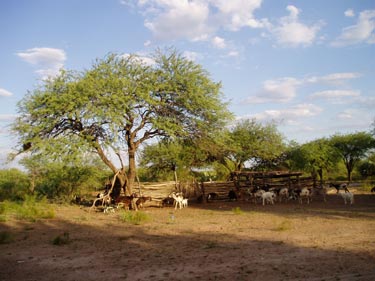
|
Santiago del Estero
Province, Argentina
© Massimo Candelori
|
Santiago del Estero has substantial environmental
comparative advantages. There are several areas that are
appropriate for the development of sustainable productive
activities that would allow for the reversing of the
current state of environmental deterioration and the
associated poverty.
Unemployment is of great concern. Government agencies,
non-governmental organizations, and the private sector are
working together to meet the demands of job creation,
thereby fostering income-creating activities for young
people.
The project will be carried out in ten municipalities of
Santiago del Estero Province. These were selected on the
basis of their potential and capacity to reflect different
provincial realities, with a view to progressive
replication of the experience to the rest of the province.
They constitute the big municipality of Santiago del Estero
City, the medium-sized municipalities of Fernandez, Loreto
and Termas de Rio Hondo, and the small municipalities of
Beltran, Campo Gallo, Colonia El Simbolar, Pinto, Selva and
Tintina. The total population of these ten municipalities
is around 280,000 inhabitants.
|
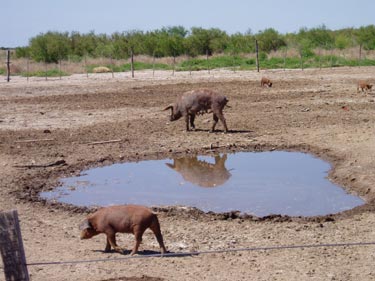
|
Santiago del Estero
Province, Argentina
© Massimo Candelori
|
The forestation activities will be carried out in the
two locations of Colonia El Simbolar and Campo Gallo.
Thirty-six plots in Colonia El Simbolar will be used for
tree plantation activities. Small farmers own thirty-five
of them. The Province owns the odd one, which is a bigger
plot.
Plantations will also be established in three plots in
Campo Gallo which are owned by big-size farmers. Nurseries
will be established in the other eight municipalities.
These nurseries will supply both the project and the local
market. The total area to be forested through the project
is 3,018 hectares.
Youth Participation in Plantation Establishment for
Combating Desertification in Aohan County, Northern
China
The goals of the project are:
- the establishment of 3,000 hectares of plantations
with different tree and shrub species;
- to improve the awareness of youth and women in
environmental protection and to promote the effective use
of land resources;
- to generate limited employment. Approximately 4,000
youth and women will participate in planting activities
during the first year, while a much lower number will
tender the plantation over five years;
- to increase local farmers' income both from
income earned during planting activities and from future
harvests;
- to facilitate technology transfer from research
institutions to the grassroots level; and,
- to implement the first “Sinks in Clean
Development Mechanism” project in China.
The project will be implemented in Aohan County, in
Northern China. Aohan lies at the southern end of the
Kerqin Sandy Land. The land is a Euro-Asian grass region
and includes many nurseries. The total land area of the
county is 800,000 hectares which includes 13 state forest
farms. The proposed project covers (but not wholly) nine
state forest farms.
|
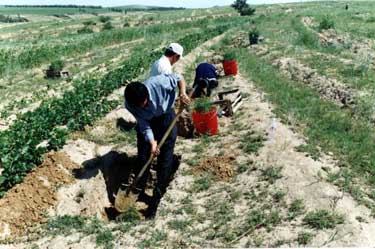
|
Agroforestry
Aohan County, China
© Xiaoxia Jia
|
Over the past few decades, the forested land area in
Aohan has expanded to 352,700 hectares. This accounts for
42.5 per cent of the total land area. An ecology system
dominated by forestry has been established in a basic form.
There is, however, still over 200,000 hectares of eroded
land, 80,000 hectares of desertified land and 120,000
hectares of degraded grassland that need urgent attention.
Severe wind erosion and desertification have caused
extensive loss of water and soil.
The ecological rehabilitation task continues to be
extensive and urgent. Afforestation activities for the
purpose of combating desertification will be the central
task in the effort to rehabilitate the ecology over a long
period of time. Good progress in the development of
forestry ecology has made forestry an effective safeguard
in the economic, social and ecological development of
Aohan. It has helped the development of forestry,
agriculture and animal husbandry progress on a sustainable
and harmonious track. Plantation establishment based on
national action plans has also become an extensive
programme.
|
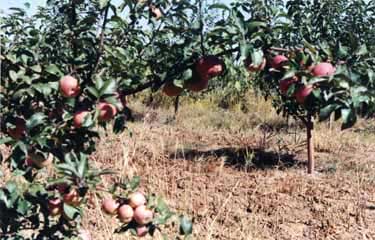
|
Apple trees on sandy
soil
Aohan County, China
© Xiaoxia Jia
|
The plantations will result in many agricultural
benefits. Intercropping with high-quality grazing grass
will produce grass seeds and provide large amount of feeds
for animal husbandry. The average net income for grazing
grass is over 750 Yuan/hectare. Therefore, the total area
of 3,000 hectares will bring a net annual income of 2,25
million Yuan.
After the trees become mature, it will be possible to
harvest timber, seeds, and firewood. It is calculated that
the gains will be over 750 Yuan/hectare and the average
annual gains would be another 2,25 million Yuan. The
proposed project will not only control sand-wind erosion as
well as desertification, but will also bring economic
benefits. These economic benefits are greater than they
would be if the land were used for farming.
As the plantations will be established on barren land
that has almost no vegetation cover in a region plagued
with sand storms they will do much in preventing further
erosion. They will also sequester carbon in a manner that
is both compliant with the Clean Development Mechanism of
the Kyoto Protocol, or that can be sold on other carbon
markets which, in turn, can earn the project participants
some extra income at the same time as benefiting the global
environment. Furthermore, the project will employ young
people which will provide them with additional job
opportunities and income as well as raising their
environmental awareness.
Youth Forestry Programme, Tete Province,
Mozambique
The goals of the project are:
- the establishment of a forest plantation of 3,000
hectares to include fruit trees that have a longer life
span so as to provide food security, income and
employment opportunities;
- to build awareness among the youth on the issues of
conservation, rehabilitation and protection of the
environment;
- to strengthen capacity building in the management of
forestry resources, providing the necessary technical
know-how and appropriate technologies; and,
- the implementation of the first Clean Development
Mechanism project in Mozambique.
The project will be implemented in the Tsangano district
in the Tete province of Mozambique. Tsangano district
covers a total land area of 3,649 km2 and has a population
of 106,557 inhabitants. The centre of the district is
located some 191 kilometresaway from Tete, the capital city
of Tete Province.
The project activities, covering some 3,000 hectares,
will be specifically located in the eight villages of
Bungue, Calipale, Chiyandame, Chicomas, Chiphole, Chitambe,
Magumbo and Mapanje. The area lies in a mountainous zone
with a cool climate. The mean annual temperature is
24°C. The average annual precipitation is more than
1200 mm. The soils are characterized as ferrasols of heavy
texture and the main crops include maize, potatoes, wheat,
tobacco and beans.
|
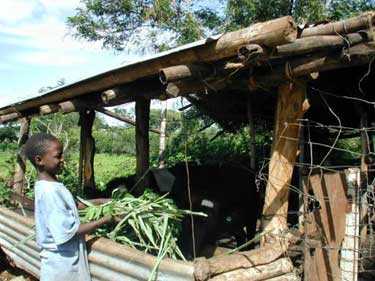
|
Creation of fodder
banks on uncultivated land
Tete Province, Mozambique
© Patrick W Matakala
|
The current Tsangano district was initially an
administrative post within Angónia district. As an
administrative post Tsangano was a new frontier waiting to
be exploited for large agricultural projects by the then
colonial power. The first agricultural activities started
in 1953 under the colonial Portuguese government causing
large tracts of miombo forests to be deforested.
Agricultural expansion and deforestation continued until
1974, a year before Mozambique’s independence and when
the Portuguese fled the country.
Upon independence, the agricultural infrastructure and
farms that had been established under colonial rule were
taken over by a para-statal company known as Complexo
Agro-Industrial de Angónia. The main crops produced
at the time were Irish potatoes, maize and fruits which
were supplied to local markets in the whole country and
also exported to Malawi. Complexo Agro-Industrial de
Angonia operated until 1989 at which time the government
decided to abandon the scheme.
By 1989, an estimated 15,000 hectares of miombo forests
had been destroyed and soil erosion and loss of soil
fertility were obvious problems. These problems continue to
date. Local authorities believe that cross-border migration
between Mozambaique and Malawi during the second half of
the 1980s due to civil war in Mozambique also contributed
significantly to deforestation in Tsangano district.
|
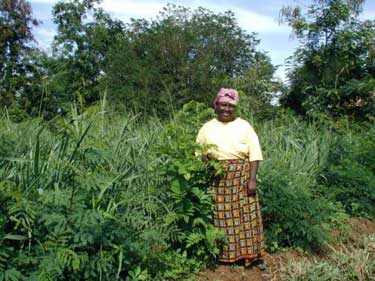
|
Creation of fodder
banks on uncultivated land
Tete Province, Mozambique
© Patrick W Matakala
|
Tsangano was seen as a new heaven for fuelwood supplies.
It is important to note that most of the deforestation
occurred in what is now Ntengo-Wa-Mbalame Administrative
Post. According to oral accounts from local elders, the
current Administrative Post of Tsangano, which covers the
villages of Chiyandame and Chitambe, was never forested. It
is anticipated that project activities in Ntengo-Wa-Mbalame
Administrative Post will focus on reforestation while those
in Tsangano Administrative Post will focus on afforestation
efforts.
The project will contribute to the country’s
sustainable development. The expected outcomes include the
following:
- income from sale of vegetables;
- income from sale of high-value fruits;
- improved soil fertility and increased crop
yields;
- mitigation against soil erosion;
- improved livestock feeding strategies;
- sale of wood products such as fuelwood and poles for
construction;
- carbon sequestration which will contribute towards
climate change mitigation; and,
- youth employment.
Current status
Joint missions of the UNCCD and the Italian Government
were fielded to all three participating countries between
July and November 2003. The purpose of the missions was to
establish the framework for implementing the projects under
the Clean Development Mechanism rules at the same time as
adhering to the mandate of the UNCCD and promoting
biodiversity.
Based on the findings of the field visits, the three
projects were deemed viable. Carbon sequestration is also
viable, in varying degrees, in all three cases. This
concurrent viability does not contravene environmental or
socio-economic targets. In fact, it is in conformity with,
and complements, these targets. The three projects are,
therefore, categorized as “carbon sequestration
through afforestation and reforestation and restoration of
degraded land”. That is, sinks in the Clean
Development Mechanism.
The results of the missions have been circulated in the
form of mission reports. In addition, project design
documents have been discussed and revised during the first
Steering Committee meeting.
In revising the project design documents, the Steering
Committee has recommended that project participants should
strictly follow the stipulations of document
UNFCCC/SBSTA/2003/L.27 on the definition and modalities for
including afforestation and reforestation activities under
article 12 of the Kyoto Protocol together with the
Intergovernmental Panel on Climate Change’s 2003 Good
Practice Guidance on Land Use, Land Use Change and Forestry
(LULUCF).
In addition, project participants were requested to
ensure that the projects are developed within the framework
of the National Action Programme to Combat Desertification
and Drought and in accordance with the synergistic approach
of the environmental conventions. Project participants were
also requested to provide a detailed description of the
site preparation activities as soon as possible in order to
start the implementation phase as soon as soon possible.
The projects should last for five years.
Field implementation of the projects will be funded
through a special contribution of the Italian Ministry for
the Environment and Territory. Looking at the
project’s budget over the total duration of five
years (excluding the carbon modelling component), the
investment for establishing the plantations ranges
approximately from US$ 300 to 315 per hectare. This cost is
well below those sought by forestry economists for
establishing similar plantations.
The projects would allow for achievement of very
substantial targets in terms of carbon sequestration. In
addition, there are very significant immediate
project-generated socio-economic benefits, encompassing,
amongst others, job opportunity creation and direct
revenues for farmers. Long-term benefits are also targeted
through the expected income generation from wooden
products. In some cases, the projects will also contribute
to reducing the migration from unproductive areas, the
illicit exploitation of natural forests, and the practice
of bush burning and its negative effects.
Further information
Federica Meneghetti, UNCCD Liaison Officer in Rome. Email:
fmeneghetti@unccd.int.
Web: www.unccd.int.
Acknowledgments
The author would like to acknowledge the Italian Ministry
of Environment and Territory, Department of Environmental
Research and Development, the Italian regional University
of La Tuscia – Department of Forest Environment
Science and its Resources, the National Coordinating Bodies
and the relevant national institutions cooperating in this
initiative in Argentina, China and Mozambique, and
colleagues in the UNCCD secretariat, in particular, Massimo
Candelori and Goodspeed Kopolo, for the information and the
support extended in the preparation of this article.






